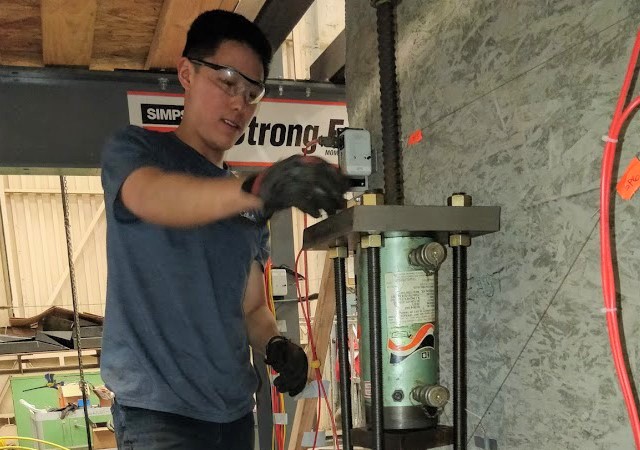A National Science Foundation grant will provide equipment for Cal Poly students to test how structures react during earthquakes.
The $340,000 grant, directed both toward students in the College of Engineering and Architecture and Environmental Design, will help fund the purchase of an equipment unit consisting of two actuators with higher force and displacement capacities than previously possible in Cal Poly’s laboratories, along with the hardware and software for automated control of the system.
“This new equipment will allow us to test, to failure, new products and assemblages to characterize their structural performance and compare with theoretical models,” said Dr. Charles Chadwell, chair of the CENG’s Civil and Environmental Engineering Department. “This opens the doors to research potential and new cross department collaborations.”
The Civil and Environmental Engineering Department, he said, has similar equipment – notably, a large actuator – that can be used to leverage the new equipment to do even more elaborate and multidirectional tests. The new large-scale equipment will be located in the CAED’s High-Bay Laboratory. There is also the possibility of a fee-for-service component for industry sponsored research.
After seeing the extensive physical effort students were putting into the large-scale structural testing with the existing equipment in the High-Bay Laboratory, Anahid Behrouzi, a faculty member in the Architectural Engineering Department, took the lead on collaborating with other colleagues and departments across campus to apply for the grant. She describes the benefits of the new equipment, stating, “The new actuator system will significantly improve the caliber of experimental research that the students can carry out and the ease of performing it.”
“We are trying to produce research quality results that can be published in journals and provide guidance to practitioners on seismic design and retrofit,” Behrouzi said. “With this grant, we will have the modern equipment to enable efficient and precise loading control of our structural tests which leads to greater data accuracy. The goal is to attract more industry-driven research projects to Cal Poly and expand student opportunities.”
Allen Estes, faculty member and head of the Architectural Engineering Department, explained how multiple constituencies will benefit from this equipment.
“Students who participate in this research will clearly benefit,” he said. “All other students will also benefit as the faculty plan to incorporate their research results into classroom instruction. The equipment will help the faculty stay current in their field and contribute to further professional development.“
Estes adds, “The research we do not only enhances the research and reputation of the university, it helps the broader profession and contributes to the body of knowledge.”
The grant will foster extensive collaboration across departments within the CAED and CENG, Chadwell said, noting his excitement for the increase in potential interdisciplinary collaboration.
“The programs listed on the proposal all work in the built environment,” he said. “It is where we all connect. Faculty in both civil engineering and architectural engineering have overlapping strengths in structural analysis and earthquake engineering. This particular area of study is where the structural engineering branch of civil engineering and architectural engineering greatly intersect.”
The new equipment, he added, will promote collaborations for the benefit of departments, the university and Cal Poly students.


